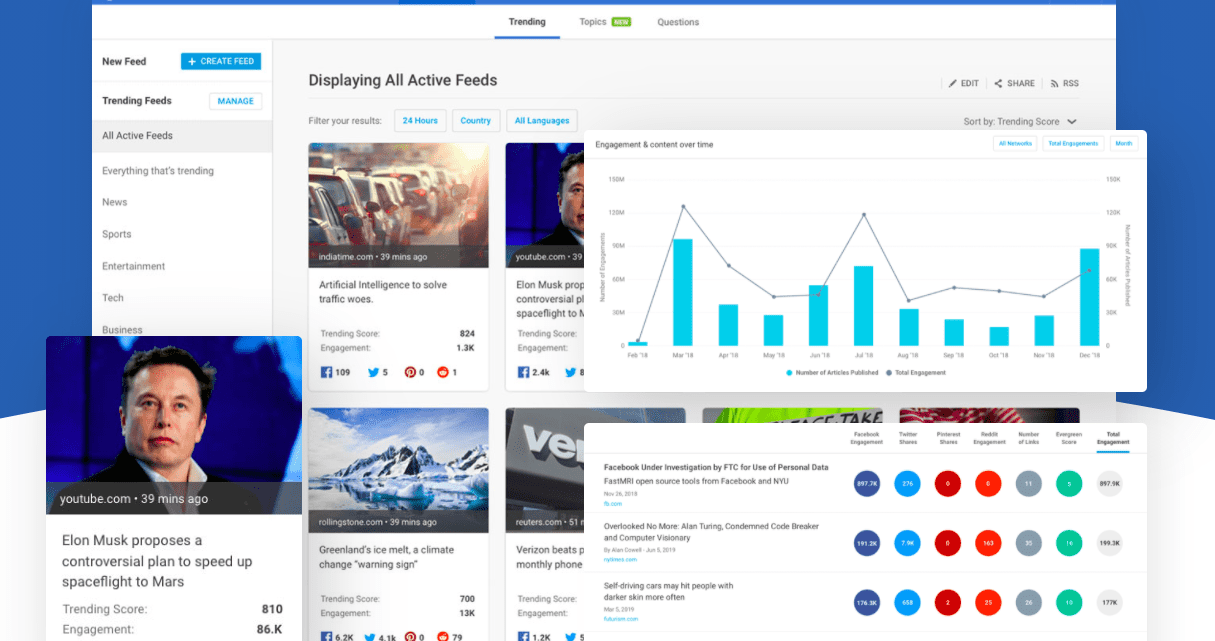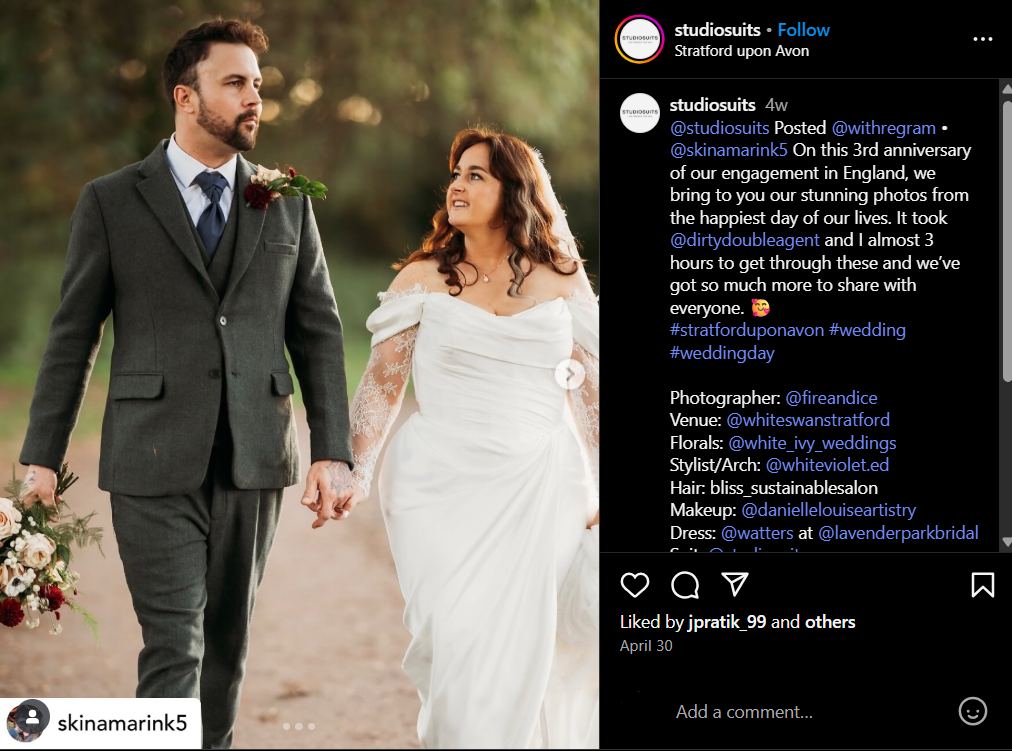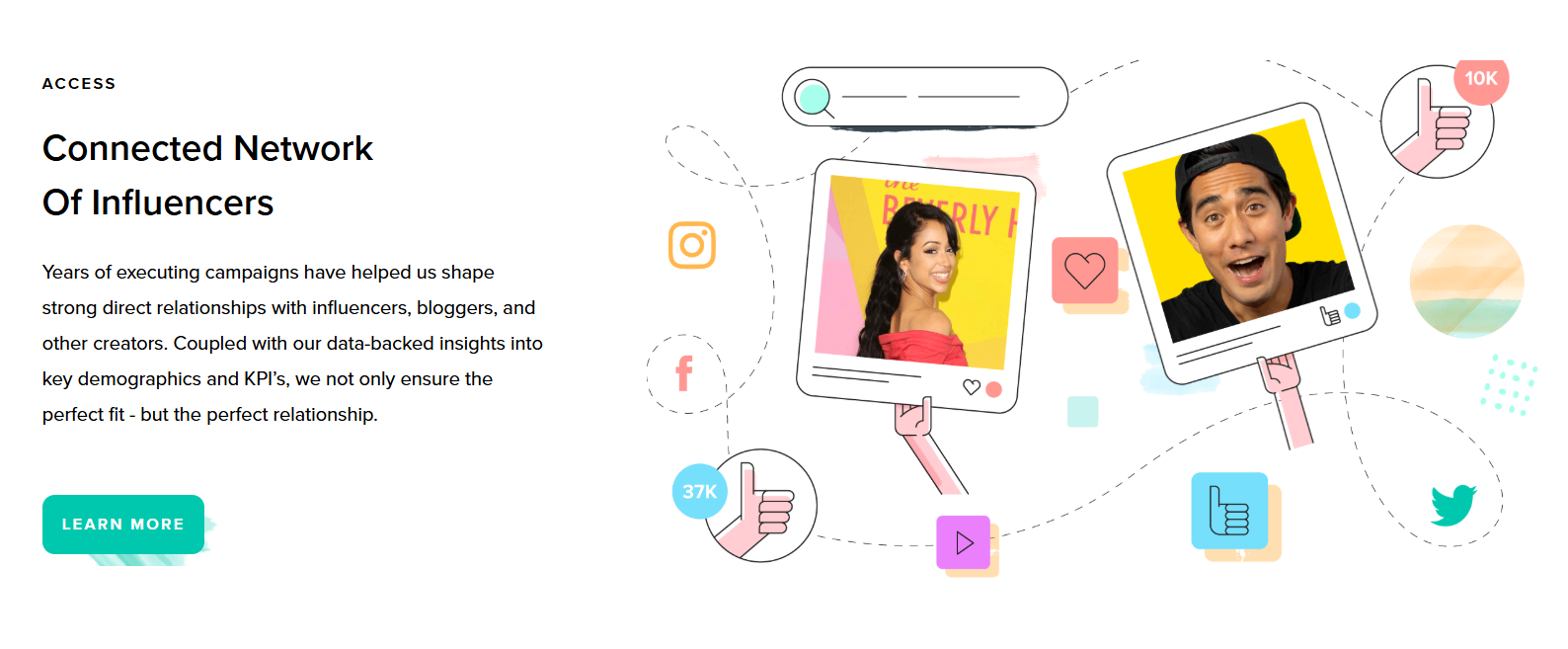Social media doesn’t move at a normal pace. It’s chaotic, messy, and lightning-fast. If your business strategy can’t keep up, you could lose visibility, relevance, and (worst of all) revenue. But when you bake speed and flexibility into your approach, you stay in front of your audience and ahead of the curve.
Let’s take a closer look at how to adapt your business strategy to keep up with social media’s upward pace and turn trends into traction.
Stay alert with social listening
Use tools like Buzzsumo, Brandwatch, or Hootsuite to track keywords, hashtags, product names, and competitor handles. (You can also use it to spot brand mentions and sentiment, and then respond in real-time or repurpose comments as social proof.)

(Image Source)
Organize your findings by category so you can spot patterns more easily. For instance, organize by product feedback, pain points, trending phrases, customer language, and competitor wins or flops.
Once you’ve gathered insights, act fast.
If you run a meal kit company and see people posting more about cooking at home with trending audio, follow suit. Record a quick demo for Instagram, and maybe create a thread around 15-minute meals, and launch a limited-time discount on your fastest recipes. (Move from insight to execution within hours so you don’t miss any trend opportunities.)
Pay attention to recurring questions and tones, too. If people ask about shipping times repeatedly, it’s a signal that you need to communicate this more. Update your FAQ page, highlight delivery windows in your posts, or create an explainer video to add to your product pages.
➜ The point is that real-time insights should always lead to real-time changes.
Funnel what you hear into product development, customer experience, and sales scripts.
Build a strategic content engine that moves fast
Focus on building systems that allow quality content to ship fast.
For example, tiered publishing guidelines can help streamline decision-making. You might decide that:
- Tier 1 content (like new jacks or trending sounds) skips review.
- Meanwhile, tier 2 content (new campaigns or complex visuals) gets a light-touch review within 24 hours.
To maintain this pace without sacrificing quality, hold a daily 15-minute content check-in, newsroom-style, in person or on Slack.
Instead of asking, “Is this ready?” ask, “How do we get this live today?”
This helps build a culture where speed is rewarded, but smart decisions still set the bar.
You can also create templates in tools like Canva to speed up design work. And establish a weekly brainstorm slot and use shared calendars so everyone knows what’s coming up.
*Pro-Tip: Use productivity tools like Notion or Trello to clarify task ownership and deadlines.
Use short videos as a key part of your business strategy to drive results
As you can tell from algorithm updates, short-form video is the most effective format on social media right now, and it’s likely not slowing down.
To take this to the next level, match your video type to your buyer’s intent.
For example:
- Early-stage leads tend to engage with behind-the-scenes content and quick hacks.
- Mid-funnel viewers are looking for credibility, so use founder explainers, expert POVs, or user-generated content (UGC).
- Late-stage potential customers respond best to social proof. Turn your best reviews into graphics or create a 30-second highlight reel of testimonials. You can also repost customer content using a repost app.
StudioSuits does this a lot.
The brand reposts wedding images and videos to showcase its custom wedding suits on real customers. This helps the brand stand out, connect with its audience emotionally, and get more people to see their wedding and formal collections.

Be sure to also choose video CTAs that feel native.
➜ Instead of “Buy now,” go for something like, “Watch how I use this daily,” or “DM us ‘free trial’ for early access.”
Also, retention is key. If viewers drop off before 5 seconds, rework your opener. If they rewatch, you’ve hit an emotional chord, so take note for next time.
Track performance, too. If it saves spike, for instance, consider turning the content into a series. Let data inform your future videos and adjust according to what your audience responds to.
Empower a fast-moving team
To move quickly, you need a lean team that knows your brand and has the authority to act.
Start with a core team, like a strategist, a content creator, and someone handling customer interactions. Train them on brand tone, visual style, escalation paths, and content guidelines. Then trust them to execute. (Just make sure they have a style guide to reference when needed.)
Make content ownership cross-functional, too.
Your customer success team hears objections daily — turn those into posts. Your sales team knows which features close deals — feed that into video scripts. Each team should be responsible for one content drop per week to keep social grounded in what actually drives revenue.
And let go of perfection.
Most social wins aren’t perfectly polished. They’re timely, real, and human.
Pro-Tip: Consider creating a #quick-hits Slack channel where anyone can pitch raw ideas. Empower creators to post directly with a three-question checklist, like: “Is it on-brand? Is it relevant now? Will our audience care?”
Use data to keep evolving your business strategy
Data is your social strategy’s GPS. It helps you double down on content themes, formats, and calls to action. For example, if every video about “remote team struggles” overperforms, that’s a potential content cluster. Consider building a mini-series or campaign around it.
Segment your results by audience type, too. And don’t post the same content everywhere.
Think of your content like a portfolio and diversify based on what each group engages with and buys from. Maybe Gen Z saves your meme content, but Gen X clicks tutorials. Tailor your platform strategy accordingly.
(Going viral is great for building awareness if the topic is relevant, but learning what works and scaling is how you build a true strategic plan.)
Be sure to track key performance indicators (KPIs) like watch-through rate, saves, and link clicks often. And then sort your content weekly:
- What worked?
- What flopped?
- What’s worth testing again?
If Reels with team members outperform product posts, adjust your mix. If customer loyalty campaigns keep paying clients on the books longer, keep rolling them out.
Turn social platforms into sales channels
People don’t want to click five times to buy something. Social shopping gets rid of those unnecessary steps and keeps users on the app.
Each platform has a sweet spot for commerce. TikTok buyers are impulse-driven, so focus on urgency and personality. Instagram shoppers want aspirational storytelling, so test carousels, Reels, and pinned FAQs to reduce friction. And Facebook is perfect for bundling offers or retargeting with testimonials.
Also, don’t rely on a single path to purchase. Shorten the path to purchase and give buyers multiple entry points to encourage as many sales as possible. Then, A/B test these paths weekly.
For instance:
➜ Looking to track link performance? Tools like Linktree or Koji with UTM tracking are great options to explore.
➜ Instant product delivery is possible by enabling auto-replies in your DMs—this streamlines the customer journey.
➜ Showcase recent work by connecting a mobile-friendly site (built with job management software) to your Instagram.
➜ Your bio is valuable real estate; include a link to your latest campaign landing page and update it as campaigns evolve.
➜For better insights, conduct a three-day test comparing CTAs such as “Tap to shop” and “See it in action,” then track the conversion rates.
Be sure to also post regularly. Posting regularly on social media helps your business stay visible and puts your offers in front of your audience often, which is pivotal to staying top of mind.
Take Cruise America, an RV rental company in Los Angeles. The brand often shares travel tips, user photos, and fun destination ideas based on real trips its customers take. This keeps its audience interested and helps the brand stand out online.
Cruise America also partners with brand ambassadors and influencers to build up UGC.
More on influencer marketing in the next section.
Get real ROI from influencer marketing
When you plan influencer marketing campaigns, think about how to create genuine, measurable results that align with organizational goals.
Here’s what we recommend:
Set clear, measurable goals
Before you approach influencers, define what success looks like for you as a business owner. Are you interested in driving traffic? Generating leads? Increasing sales? Make sure your goals align with your overall business objectives and keep them measurable.
Set specific KPIs, like:
- Lead Generation: Measure how many sign-ups or form submissions come from influencer-driven traffic.
- Brand Awareness: Use tracking tools to gauge engagement (likes, comments, shares) and impressions.
- Sales Conversions: Track promo codes, unique links, or affiliate links to monitor direct sales.
Pick the right influencers
Not all influencers are created equal. Choose influencers who genuinely align with your brand values and whose audience overlaps with your target market.
Use tools like NeoReach to identify influencers with authentic engagement in your niche market.

(Image Source)
Note that micro-influencers tend to deliver more value than mega-influencers because their audiences tend to trust them more.
Negotiate for performance-based compensation
If you’re not measuring ROI and customer satisfaction, you might be wasting money on influencer partnerships that aren’t a good fit.
Instead of paying flat fees, consider negotiating for performance-based deals. Pay influencers based on the results they deliver, whether that’s a fixed cost per click, a percentage of sales, or a cost-per-acquisition (CPA) model.
Create authentic, valuable content
The best influencer content doesn’t feel like an ad. It feels natural and tailored to your target customer. Focus on partnerships that allow influencers to showcase your product in a natural, engaging way. Encourage influencers to tell their stories, showcase real-life usage, and create behind-the-scenes content, even better if they use tools like AI Voice to enhance accessibility and storytelling quality.
When the content is authentic, it resonates with their followers and drives higher engagement, which in turn leads to higher ROI.
Leverage influencer partnerships across channels
Don’t let your influencer content live in one place. Repurpose it across your website, social media, and email campaigns to maximize its value.
An influencer post can become a testimonial on your homepage or a featured piece in your next email blast, for instance.
Track your marketing plan efforts and optimize
Always measure how well your influencer campaigns are performing.
Use tools like Google Analytics and UTM parameters to track how much traffic comes from influencer links and how that traffic converts. A strong conversion rate means you’re getting real ROI. If not, adjust your strategy. Test different messaging options, change the influencer, and try new formats.
Wrap up
You don’t need to predict the next trend to have a marketing strategy that works.
But you do need to be ready for it. Build a strategy that listens, reacts, and evolves in real time. That’s how your business stays ahead while everyone else plays catch-up.
Want help creating a faster, smarter social strategy?
Let’s talk.
Partner with NeoReach, a leading global influencer marketing agency, to create strategic campaigns that deliver real results. Start maximizing your ROI today! Contact NeoReach now.




